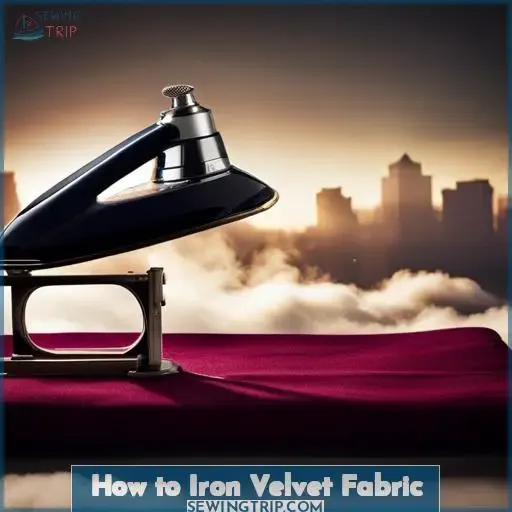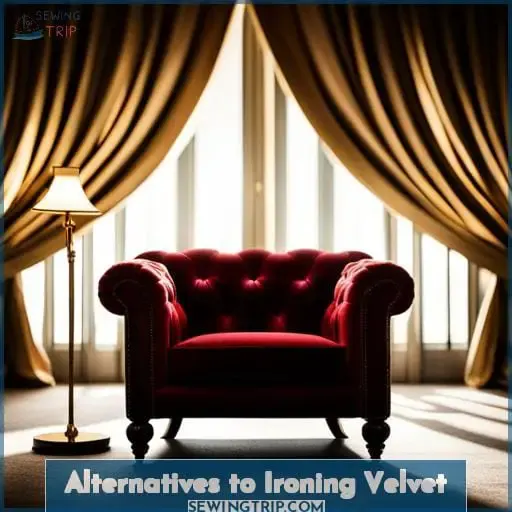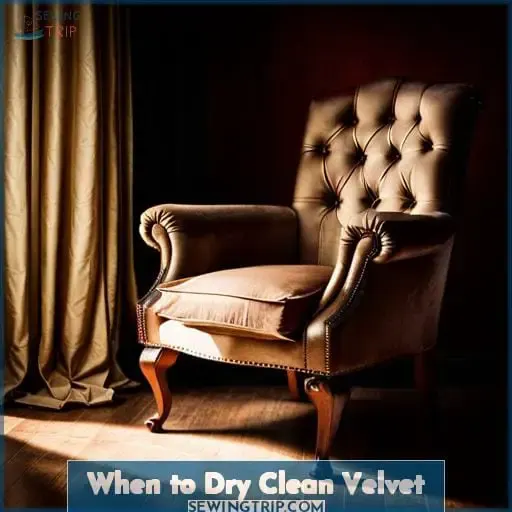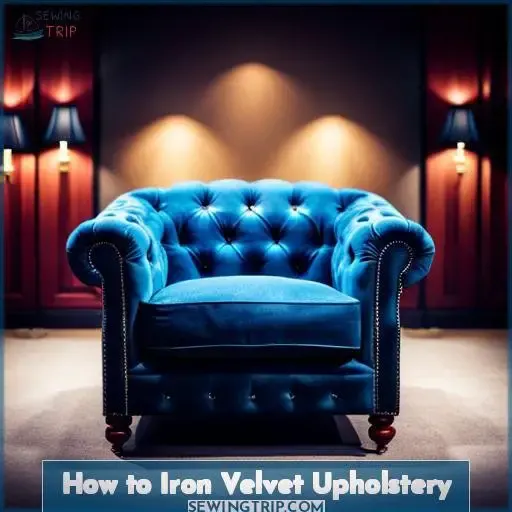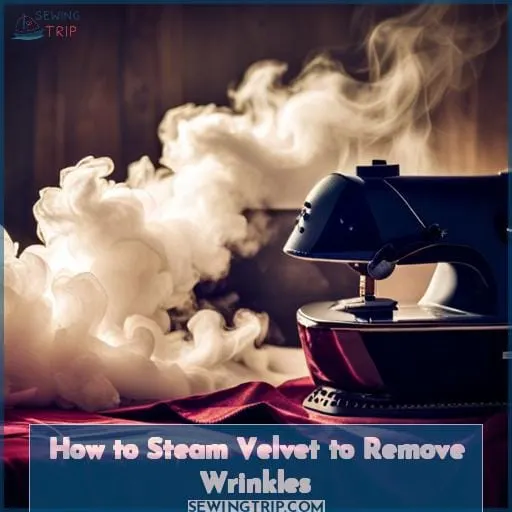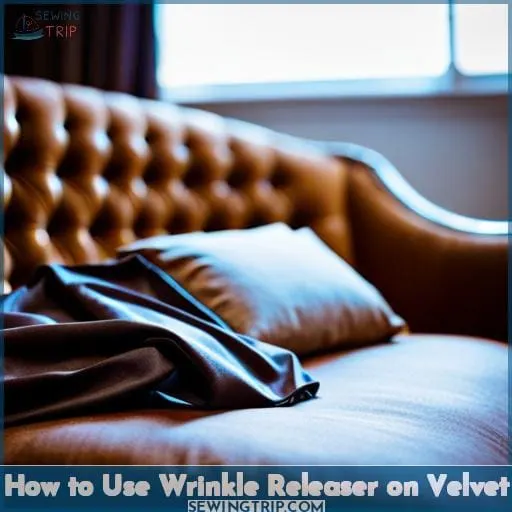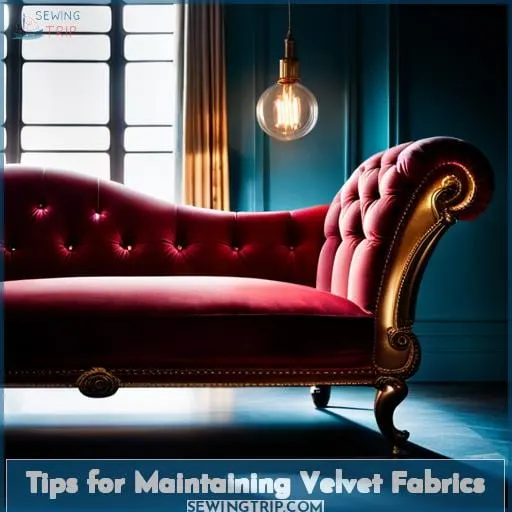This site is supported by our readers. We may earn a commission, at no cost to you, if you purchase through links.
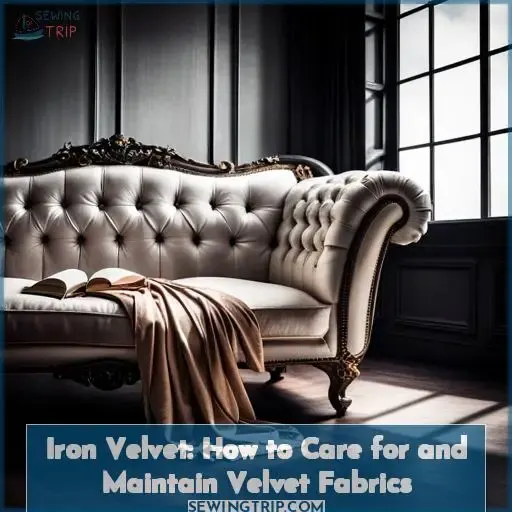 Ironing velvet can be difficult if not done correctly, as it can leave permanent marks or even melt certain types of fabric. Fortunately, there is a safe and effective way to iron this delicate material without causing any damage.
Ironing velvet can be difficult if not done correctly, as it can leave permanent marks or even melt certain types of fabric. Fortunately, there is a safe and effective way to iron this delicate material without causing any damage.
This article will provide you with tips on how to iron velvet upholstery and garment fabric, alternative methods of removing wrinkles from the material without having to use an iron at all, when it is necessary to dry clean velvet items such as clothes and upholstery pieces like furniture covers or cushion covers, as well as how best to store velvet fabrics in order to maintain their luxurious look and feel over time.
With these easy-to-follow instructions on caring for iron velvet, you can keep your velvet looking its best. Always start by checking the fabric care label and following any special ironing directions.
Use a medium-hot iron and press on the wrong side of the fabric to avoid damaging the nap. Place a pressing cloth between the iron and the velvet. Lift the iron as you move it instead of sliding to prevent scratches.
If ironing velvet is not possible or desired, try hanging the item in a steamy bathroom or lightly misting it to let the wrinkles fall out naturally. When storing velvet, keep it flat or hang on a padded hanger. Avoid folding it for long periods, which can lead to difficult creases.
With proper care, your velvet pieces can maintain their beauty while still being enjoyed.
Table Of Contents
- Key Takeaways
- How to Iron Velvet Fabric
- Alternatives to Ironing Velvet
- When to Dry Clean Velvet
- How to Care for Velvet Clothes
- How to Iron Velvet Upholstery
- How to Steam Velvet to Remove Wrinkles
- How to Use Wrinkle Releaser on Velvet
- How to Store Velvet Clothes and Accessories
- Tips for Maintaining Velvet Fabrics
- Conclusion
Key Takeaways
- Use a medium-hot iron on the wrong side to protect the nap.
- Always place a pressing cloth between the iron and the velvet.
- Lift the iron instead of sliding it to prevent scratches.
- Steaming is a gentle alternative to ironing velvet.
How to Iron Velvet Fabric
When ironing velvet, understanding the fabric’s fiber content and first testing your iron’s heat and steam settings are crucial to avoid damage. Carefully set up your ironing surface with a needle board or towel, then use proper ironing techniques by avoiding direct contact with the velvet’s pile and employing a press cloth when needed.
For some fabrics, steaming or a wrinkle release spray may also safely relax the velvet’s wrinkles.
Assess Fiber Content
You’ll want to check the tag to see what the velvet is made of before firing up the iron.
- Cotton
- Silk
- Rayon
- Polyester
- Acetate
Knowing the fibers lets you tailor heat, steam, and pressure to avoid damage. Velvet’s delicate pile requires a gentle approach.
Test Iron Settings
When experimenting with ironing velvet, adjust the heat and steam pressure as a scientist tweaks variables in the lab. Use caution when steaming some velvet fabrics, as certain types cannot handle moisture.
To prevent crushing the delicate pile, store velvet garments rolled or hanging. For upholstery velvets, vacuum regularly and spot-clean stains. Gentle ironing helps remove wrinkles from velvet, so prioritize protecting the pile when pressing.
Focus on being delicate when ironing to avoid damaging the fabric. Store velvet properly and keep upholstery velvet clean to minimize the need for intensive ironing. Adjust your ironing approach based on the velvet type, pile sensitivity and wrinkling.
With care, ironing can refresh velvet without harming the special fibers and texture.
Set Up Ironing Surface
Use a needle board or towel so you don’t flatten the velvet. This protects the delicate pile from damage, allowing the velvet to maintain its luxurious texture after ironing. To avoid flattening the velvet, a needle board or towel should be used. The delicate pile is protected from damage this way.
Ironing Technique
Slide the seam roll up sleeve seams to preserve the velvet nap.
- Hover the steamer lightly across the velvet front to release wrinkles.
- Press the velvet backside only, using a cloth for protection.
- Lift and gently brush the pile to restore texture after ironing.
Iron velvet carefully, focusing heat on the backside. Utilize steam and accessories such as cloth and a seam roll to avoid flattening the delicate pile.
Steaming Velvet
Bring the gentle mist to caress her plush ringlets, coaxing them softly. Steaming velvet provides a gentler touch than ironing, avoiding crushing the pile. Delicate textures thrive with steaming, though test on a sample first. When in doubt, velvet prefers mist to an iron for pile protection.
Using a Wrinkle Release Spray
Spritz a wrinkle release spray on the velvet to relax wrinkles without impacting the delicate pile.
- Use professional-grade spray like Downy or Commercial Magic to treat wrinkles.
- Apply a light mist holding the can 6-8 inches from the garment.
- Gently smooth the fabric; do not overwork the area.
- Allow the item to sit for 1-2 minutes before wearing or ironing. Velvet’s intricate texture requires a delicate approach when attempting to release wrinkles. A specialized spray can relax fibers without damaging the luxurious piled surface. With proper technique, the velvet will regain its flawless drape and supple hand.
Alternatives to Ironing Velvet
When it comes to caring for delicate velvet, you’ll want to avoid directly ironing the fabric’s pile. Steaming velvet instead of ironing, hanging garments to prevent wrinkling, or using a clothes steamer are gentler options that will keep the luxurious texture of your velvet looking its best.
Steaming
Get steamy with it while gently hovering above that velveteen vice. Select a fabric steamer with variable steam control to rejuvenate velvet. Steam technology relaxes fibers, eliminating wrinkles without the potentially crushing contact of an iron.
Refresh your velvet upholstery as well; steaming revives the plushness of the pile.
Hanging Method
Simply hang the velvet garment immediately after laundering. Prevent velvet wrinkles by hanging it properly. Use wide, padded hangers to evenly distribute the garment’s weight. Hang velvet pieces vertically to maintain the pile’s plush texture.
Allow ample space between hanging velvet items. Let the velvet finish drying completely before closing closet doors.
Using a Clothes Steamer
You’d be wise to place the velvet on its back over padding, then wave a gentle breeze across its form. Choosing a velvet wrinkle releaser like a steamer allows you to gently relax the fibers without crushing the pile.
Steaming technique protects velvet upholstery or accessories better than ironing; hold the steamer above the fabric to prevent moisture damage.
When to Dry Clean Velvet
You’ll want to spot clean velvet when possible, gently dabbing stains instead of scrubbing. For deeper cleaning needs that require full immersion, rely on professional dry cleaning to avoid damaging the delicate pile.
Spot Cleaning
When life gives you velvet stains, reach for the spot cleaner and gently dab away those troubles. Avoid harsh scrubbing motions when spot cleaning velvet. Instead, use a clean, dry cloth to blot liquid spills right away.
For set-in stains, use velvet’s pile to your advantage and brush stains out from the base. Test colorfastness on an inconspicuous area first when using a commercial spot treatment. With care, even delicate velvet can be spot cleaned successfully. Fabric-specific techniques keep your velvet looking luxurious.
Professional Dry Cleaning
Ya should send delicate velvets to a reputable dry cleaner for a gentle, professional touch. They have the proper tools and expertise for handling velvet’s pile without crushin’ it. Trust the velvet fabrics ya cherish to dry cleanin’ pros with experience removin’ stains and preventin’ damage durin’ cleanin’ and pressin.
Ya’ll avoid frustrations tryin’ to iron velvet yourself and ensure your velvets retain their luxurious look with specialized care.
Use a dry cleaner experienced with velvet who follows green practices. Request light steam press without direct contact on the velvet pile. Ask about fabric-safe cleanin’ agents and low temperature settings. Have velvet upholstery professionally cleaned to refresh without harming the delicate fibers.
How to Care for Velvet Clothes
When caring for velvet clothes, proper handling and storage are key. Have velvet professionally cleaned to maintain the fibers and pile. Velvet is a delicate fabric that requires special care. Hang velvet items on padded or wide hangers to retain the shape and drape.
Fold velvet loosely and avoid overly tight creases. Before storing for the season, have velvet professionally cleaned, then wrap in acid-free tissue paper. Store velvet in a cool, dark place to prevent damage from light and humidity. Regular professional cleaning can remove embedded dirt and refresh crushed pile.
Frequent steaming and brushing with a velvet brush also revives pile and maintains the luxurious texture of velvet. With proper care and handling, velvet clothing and furnishings can remain beautiful for many years.
Handling and Storage
You’re wise to handle velvet with care – roll, don’t fold, it for storage. Limit folding velvet since it can leave unsightly creases. Gently roll garments or yardage instead. Before storing, let velvet fabrics fully air dry.
Use breathable garment bags or acid-free tissue when packing away velvet. For spot cleaning, spritz with eco-friendly solutions, then allow it to dry. With mindful handling and storage, your velvet’s pile and sheen will be preserved.
Professional Cleaning
Tis best to have your velvet professionally cleaned to maintain that luxurious texture. Choose an eco-friendly cleaner. Sustainable solutions use vegan products in plastic-free cleaning. Testimonials praise Iron & Velvet’s water-soluble sachets, customizable delivery, and commitment to being vegan and cruelty-free.
Their cleaning products tackle dirt without harming the earth. Customers like Claire find Iron & Velvet their favorite eco-friendly option.
How to Iron Velvet Upholstery
Before ironing velvet upholstery, you’ll want to check the fabric content and test your iron’s settings on an inconspicuous area. Then, lay the velvet out pile-side down on a towel or velvet pressing cloth to prevent flattening the pile as you gently press over it with a medium-hot iron.
Assessing Fabric Content
Before pressing velvet upholstery, it’s wise to gently pinch a hidden corner between your fingers to feel if the pile crushes – that’ll help you determine the fiber content and ideal iron temperature.
- Test an inconspicuous area.
- Begin with a lower heat setting and no steam.
- Adjust the heat and steam based on the fabric’s reaction.
With a compassionate heart and patient wisdom, you’ll unlock the mysteries of ironing velvet’s enchanted texture.
Testing Iron Settings
Start with a low heat setting and light steam to find the ideal ironing approach for the velvet. Assess the fiber’s tolerance; synthetics and silks need less heat. Test on an inconspicuous area first. Adjust the temperature and steam incrementally, checking after each pass. The goal is wrinkle removal without flattening the pile completely.
Relax the fibers with steam and let sections dry between pressing. The perfect heat and moisture balance preserves the velvet’s luxurious texture.
Preparing the Upholstery
You must brush the nap clean before pressing it properly. Tend to your velvet upholstery with care, gently using a soft brush to lift dust from the delicate pile. Respect the fabric’s need for tidiness, for cluttered fibers press unevenly. Prepare surfaces before applying heat, and avoid overworking the delicate threads.
With mindfulness, create an inviting space to luxuriate upon. Upholstery requires care akin to caring for oneself – gentle, patient, consistent upkeep for comfort and beauty.
How to Steam Velvet to Remove Wrinkles
When refreshing velvet fabric with steam, start by selecting an appropriate steamer based on the velvet type and fabric content. Then, prepare the velvet by inspecting for pilling or fraying and treating any spots or stains so they don’t set.
Steaming to remove wrinkles comes next, using light pressure and avoiding prolonged direct contact.
Choosing a Steamer
For steaming velvet, you’ll want to pick a lightweight portable model. Consider steam power, tank capacity, and heat-up time when selecting a handheld garment steamer. Brands like Conair and Rowenta offer quality travel steamers under $50. Compare features like auto shut-off, dual voltage, and extra accessories.
Aim for at least 15 minutes of steam time. Check owner’s manuals on descaling and cleaning to maintain performance. Portable steamers allow wrinkle removal without an ironing board and make touch-ups easy.
Steaming Technique
You’re going to want to hold the steamer about an inch above the velvet to avoid flattening the pile as you lightly pass over wrinkled areas, using a 50% overlap for maximum efficiency according to experts.
Steaming velvet provides a gentle, pile-friendly alternative to ironing for removing stubborn wrinkles. Prevent water saturation and rapid cooling by holding the steamer above the fabric rather than directly on it.
Overlap steam passes with light, slow movements to generate a smooth surface while respecting the velvet’s delicate texture. Conclude steaming with care to restore the luxurious look and feel of your velvet.
Preparing the Velvet
Check the care label and test steam on an inconspicuous area before prepping your velvet. Evaluate the fiber content and construction. Use a garment steamer, not an iron. Hang over towel rods or shower curtain rods to allow gravity to smooth wrinkles.
When steaming acetate or triacetate velvets, hover the steamer above the fabric without direct contact. Opt for dry cleaning if unsure about heat, steam, and moisture tolerance. Velvet dry cleaning avoids potential damage from home methods.
Request light steam or no steam during processing. Let specialty cleaners tackle sensitive fabrics.
How to Use Wrinkle Releaser on Velvet
When working with delicate velvet fabric, a wrinkle releaser spray can help smooth out folds and creases without directly ironing the material. To use a wrinkle releaser, first select a spray formulated for velvet or delicate fabrics.
Then, lightly mist it over wrinkled areas and gently smooth the fabric with your hands.
Choosing a Wrinkle Releaser
To prevent crushing the pile, spray a light mist of wrinkle releaser onto the back of the velvet. Choosing a wrinkle releaser depends on the velvet’s fiber and pile. Test options to find an effective, eco-friendly product that relaxes wrinkles without flattening the fabric.
Use sparingly and focus on technique over excessive spraying. Your approach impacts results more than the releaser brand does. Follow fabric care instructions and experiment on an inconspicuous area first when maintaining velvet.
Applying the Releaser
After misting the wrinkle releaser, hold it 10-12 inches away and lightly apply to the velvet using a sweeping motion for 5-7 seconds. Studies show this ensures even distribution without oversaturating the delicate fabric.
When treating velvet upholstery, first test an inconspicuous area before applying the eco-friendly wrinkle releaser to the entire surface. This allows you to check for potential color change while enabling effective velvet care and wrinkle removal.
Removing Wrinkles
Hold the releaser 6 inches away and lightly mist over wrinkled areas. Gently rub to redistribute the pile. Next, gently stretch out affected areas with hands or a nap-protecting brush. Finally, repeat spraying, rubbing, and stretching until wrinkles diminish.
This technique reactivates velvet fibers without damaging the pile or seams, providing eco-friendly cleaning for upholstery, accessories, and ironing techniques using wrinkle releasing sprays.
How to Store Velvet Clothes and Accessories
When storing your velvet clothes and accessories, preparation is key. Start by lightly cleaning the items to remove any debris or dust particles before carefully folding or rolling them in acid-free tissue paper.
Avoid humid environments that may damage the pile, and store in a temperature-controlled space to prevent damage from moisture.
Cleaning Before Storage
Clean those velvet darlings before you stash them, honey. With velvet, eco-friendly cleaning before storage is key. Dust with a lint roller, spot clean gently with a damp cloth. Let air dry thoroughly.
Use that needle board for ironing, finger caps for safety. Proper preparation preserves your velvets, so they stay soft and plush when you take them back out.
Using Acid-Free Tissue Paper
Wrap your velvets with acid-free tissue before boxing them up. This protects the delicate fibers while allowing air to circulate. Opt for 100% recycled tissue that’s pH neutral, chemical-free, and sustainable. Roll velvets vs.
folding to keep the pile intact. Store flat in breathable boxes to prevent crushing creases.
Avoiding Moisture and Humidity
To prevent ruining your precious velvet, you’ve got to stash it somewhere with low humidity, as excess moisture can irreversibly damage the fibers over time.
- Use a dehumidifier or air conditioner to regulate humidity.
- Try hanging velvet in a closet, not folded in drawers.
- Store it in breathable fabric like cotton, not plastic.
- Add silica gel packs to absorb moisture.
Keeping velvet away from moisture through smart storage techniques will help it maintain that luxurious texture for years to come.
Tips for Maintaining Velvet Fabrics
Maintaining the beautiful lush texture of velvet requires some special care. To keep your velvet fabrics looking luxurious, brush them regularly to lift the crushed pile, avoid friction from rubbing, and have them professionally cleaned when needed.
Regular Brushing
You’ll find regularly brushing maintains velvet’s luxurious texture. Using a soft brush against the velvet’s nap lifts crushed fibers and prevents permanent pile damage. For upholstery, gently yet firmly brush the entire velvet surface frequently. Steaming and wrinkle removal between professional cleanings prolongs the velvet.
When storing velvet items, allow air circulation to avoid permanent creases from forming.
Avoiding Friction
When ironing velvet, you have to be gentle with the pile or it will end up matted.
- Don’t rub the fabric together.
- Lift the fabric while ironing.
- Use steam carefully.
- Store hanging, rather than folded.
With a delicate touch, you can maintain velvet’s sensual texture for years. Luxury fabrics reward those willing to handle them with care.
Professional Cleaning Recommendations
Take velvet to a professional dry cleaner you trust to gently clean and steam it. Their expert techniques like steaming and brushing maintain the delicate texture without crushing the pile. Request eco-friendly solvents to protect the fabric and the environment. Needle boards support velvet’s pile when ironing at home between cleanings.
Conclusion
Caring for your velvet fabrics can be a daunting task, but with the right knowledge and tools, it can be straightforward and even enjoyable. Iron Velvet offers helpful tips to maintain the beauty of these luxurious fabrics.
First, assess the fabric content and find care instructions to understand how to best care for the material. Test iron settings on an inconspicuous area; velvet often requires a lower heat. Use a wrinkle release spray before ironing to help the fibers relax and make wrinkles easier to remove.
Alternatives to ironing such as steaming and hanging can also be used to remove wrinkles and creases without the harsh heat of an iron. When ironing upholstery, always prepare the fabric properly by vacuuming and brushing first; then test the iron settings in an inconspicuous spot before proceeding.
With proper care and attention paid to assessing fabric, testing temperatures, and using alternative methods when possible, velvet fabric can remain looking beautiful and stylish for years.

